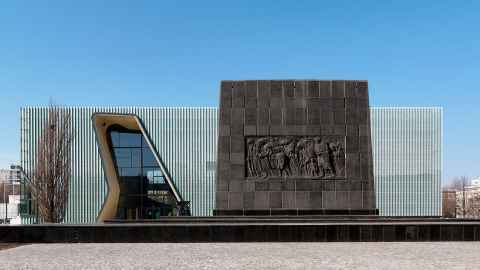Curating between hope and despair
1 March 2019
An extraordinary museum on the site of the Warsaw Ghetto in Poland is a symbol of hope after one of the darkest periods in history.

The 20-year creation and international significance of the POLIN Museum of the History of Polish Jews is the focus of an upcoming public lecture by its chief curator, Professor Emerita Barbara Kirshenblatt-Gimblett from New York University.
She says the stunning glass museum, full of light, air and space, "began from the rubble, without a building or a collection, but with the greatest treasure of all, a story to tell; all the drama is on the inside".
The museum completes the memorial complex that began with the Monument to the Ghetto Heroes, which sits in front of it.
"At the monument we honour those who died by remembering how they died, at the museum we honour them by remembering how they lived," she says.
"My lecture explores the creation of POLIN Museum and its multimedia narrative exhibition as well as its potential to be an agent of transformation that can move an entire society forward."
By promoting openness, tolerance and truth, POLIN Museum contributes to mutual understanding and respect.
Starting from the Middle Ages and encompassing eight galleries, the core exhibition looks at the beginnings of Jewish settlement in Poland, the development of Jewish culture and the social, religious and political diversity of Polish Jews, and dramatic events from the past, culminating in the Holocaust. A final gallery depicts Polish Jewish life in modern times.
A vibrant hub in the city, POLIN also runs temporary exhibitions, educational activities, conferences, and academic and artistic residences.
Professor Kirshenblatt-Gimblett sees the museum as a place "where people can confront the stereotypes and face the perils of today's world, such as xenophobia and nationalistic prejudices".
"By promoting openness, tolerance and truth, POLIN Museum contributes to mutual understanding and respect."
Before the Holocaust, Poland had one of the largest Jewish populations in the world. By 1945, three million Polish Jews, 90 percent of the pre-war Jewish population, had been murdered or perished. In total, about six million Jews perished in the Holocaust.
Professor Kirshenblatt-Gimblett's lecture, "Curating between hope and despair: Creating POLIN Museum of the History of Polish Jews", is on Tuesday 12 March at 6pm at Old Government House.
Media queries
Julianne Evans | Media adviser
Tel: 09 923 6589
Mob: 027 562 5868
Email: julianne.evans@auckland.ac.nz